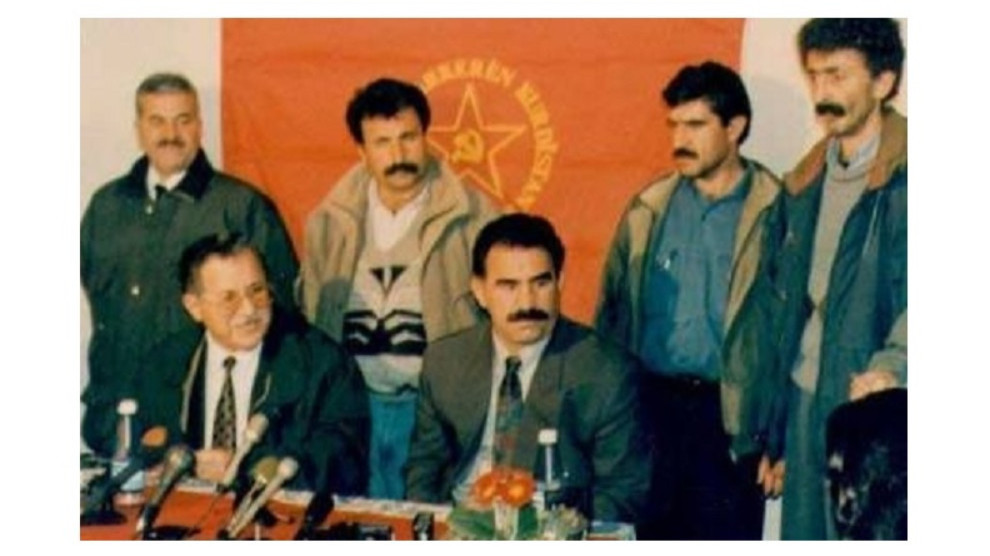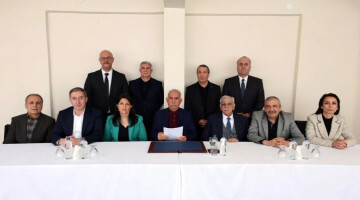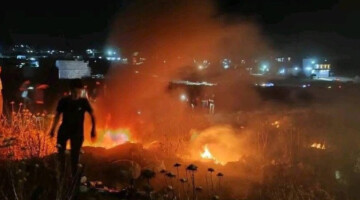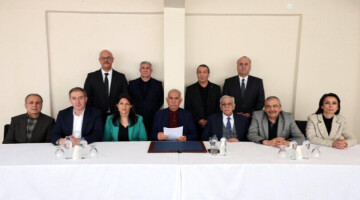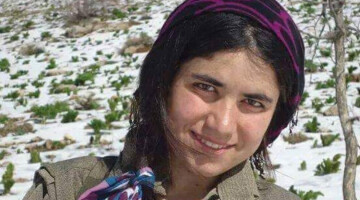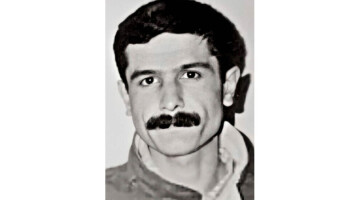The fall of the Berlin Wall in the last days of 1989 would create a domino effect in the Eastern Bloc countries. While the European political map was changing with the collapse of the bloc and the Soviet Union, a wind of uprising and freedom was blowing in Northern and Southern Kurdistan. However, the New World Order strategy was not accepting peoples with free will and their leaders. Having anticipated the things to come in the region and the world, Kurdish People’s Leader Abdullah Öcalan would channel all his energy into the resolution of problems through dialogue and achievement of unity among Kurds.
THE 4 JANUARY 1991 MEETING AND THE 1992 TREASON
As a first step, Öcalan met with the Patriotic Union of Kurdistan (PUK) Leader Jalal Talabani on 4 January 1991. The main agenda of Öcalan, who had also met with the Kurdistan Democratic Party (KDP) Leader Massoud Barzani before, was the establishment of an alliance between Kurdish forces. Talabani, who would later be remembered as one of Öcalan’s close friends, said the following during this meeting: “We are here to be entirely open and to discuss all the issues we want to. As the Iraqi Kurdistan Front, we appreciate the PKK’s struggle. There is a lesson we have drawn from history: The stronger the relationship, dialogue and alliance between Kurdistan national forces is, the healthier the Kurdish national struggle will become. The more Kurdish forces are in conflict, the more the ground will be harmed.”
Abdullah Öcalan’s remarks during that meeting would go down in history as follows: “10 years ago, we wanted to establish relationship with the Kurdish parties in the South (of Kurdistan). Many reasons prevented the parties in the South and the North from marching in unity. We dwelled on this issue several times. From now on, we must focus on what we could agree upon.”
Implying the existence of challenges before Kurdish unity, Öcalan acted cautiously and foresaw the upcoming danger. This anticipation of Öcalan would become true a year later, as the Turkish state and some regional and global powers wanted PUK and KDP to fight against the PKK in return for giving green light to the federal structure in Southern Kurdistan. The “dark days” in recent Kurdistan history were at the doorstep and the Southern Kurdistan Parliament made two decisions during its first session in Hewler (Erbil) on 4 October 1992; its relationship with the central Baghdad regime and the fight against the PKK.
Shortly after this meeting, Southern Kurdistan forces started a war against the PKK guerrillas together with the Turkish army. The objective of this war was to root the Kurdistan guerrilla especially out of Heftanin, Zap and Xakurke areas. However, the treason and resistance that progressed during Kurdish history would come in sight at that stage. Gülnaz Karataş (Bêrîtan), who fought to the last bullet on 24 October 1992, would fall a martyr by jumping off a cliff instead of surrendering to the KDP forces. This action is the turning point of the period called the “1992 South conflict”.
While the PKK reached an agreement with the forces in the South after a conflict of 45 days, the then President of Turkey, Turgut Özal, wanted Talabani to step in for a solution to the Kurdish question. During the days of a message traffic between Özal and Öcalan through Talabani, a peace process was being discussed behind the scenes in Ankara. Turkey’s Prime Minister of the time, Süleyman Demirel, would make the following comment on the process: “The state cannot negotiate with those shedding blood. It is not the state that is spilling blood. Let these people come and surrender before it is too late and submit themselves to justice.”
FIRST CEASEFIRE
Despite the various voices rising in Ankara, the Kurdish People’s Leader took a historic step for peace and appeared on world media in the town of Bar Elias in Lebanon on 19 March 1993. During the press conference here, he declared unilateral ceasefire from 21 March to 15 April 1993. While the Turkish state took no serious step in response to the peaceful hand offered by the Kurdish People’s Leader, 15 April, the termination date of the ceasefire, was drawing near. Özal once again invited Talabani to Ankara and expressed his request for the extension of the ceasefire.
EXTENSION OF CEASEFIRE AND ÖZAL’S DEATH
On 16 April 1993, Öcalan once again appeared before the media. This time, he was accompanied by Talabani, as well as the Kurdistan Socialist Party (PSK) Leader Kemal Burkay and Kurdish politician Ahmet Türk. Not even 24 hours after the extension of ceasefire, the media reported on 17 April 1993 the death of Turgut Özal. While the Turkish state officially declared his cause of death as a heart attack, Özal’s death opened a new page both in the recent history of Turkey and the Kurdish Freedom Struggle.
CONFLICT UNIT AT WORK IN ANKARA
After Özal’s death, the Turkish state changed hands, so to speak. On 25 May 1993, as many as 33 soldiers of the Turkish army were killed by guerrillas led by Şemdin Sakık on Bingöl-Elazığ highway. Öcalan interpreted Özal’s death and this incident as provocations seeking to disturb the ceasefire and escalating the conflict. During those times with Süleyman Demirel as president, Tansu Çiller as prime minister, Mehmet Ağar as security director and Doğan Güreş as the chief of defence, 33 intellectuals were burned to death in Sivas. In the face of the preparations made by the new conflict unit at work in Ankara, Öcalan announced the termination of the ceasefire on 8 June 1993. While the hand he had thrusted out for peace hanged in the air, -as would be seen in the following ceasefire processes- the Turkish state would put a conflict and destruction strategy into operation in Kurdistan.
Seeking to escalate the war, the Turkish state in 1995 took the KDP forces into its service and launched repeated attacks on guerrilla positions in Southern Kurdistan under various covers. On 11 July 1995, in Dublin, an agreement was signed with forces from Southern Kurdistan in line with the interests of England, the US and Turkey. One of the objectives of the agreement was the elimination of the Kurdish Freedom Movement led by the PKK. Indeed, clashes erupted between KDP forces and PKK guerrillas after a short while and lasted three months.
THE SECOND CEASEFIRE AND BOMBING IN DAMASCUS
The developments in 1995 would not remain limited to this. As preparations were underway for the 24 December general election in Turkey, Turkish officials demanded ceasefire from Öcalan through some intermediaries. To obviate another period of conflict after two years of fierce battle, Abdullah Öcalan announced ceasefire on live broadcast on MED TV on 15 December 1995. After the elections held in Turkey and Northern Kurdistan, in the first says of 1996, Ankara’s response to the ceasefire would be a massacre.
In Güçlükonak district of Şırnak, a minibus was first riddled with bullets, then burned down on 16 January 1996. The Turkish Chief of Defence, speaking after this incident in which 11 Kurdish civilians were massacred, tried to put the blame on the PKK but it came out after a short time that the perpetrator was JITEM (Intelligence Service of the Gendarmerie), which acted as the Turkish state’s death machine in Kurdistan. The Turkish state’s response to ceasefire would not be restricted with this alone. As the conflict in Kurdistan escalated in the winter of 1996, a vehicle laden with C4 explosives detonated on 6 May near the house where Öcalan was staying in Damascus.
Abdullah Öcalan survived this assassination which had been organised by the prime minister of the time, Tansu Çiller, and her team. Speaking to MED TV that night, Öcalan said: “We talk of peace and fraternity, we want this war to end but we get bombs in response”.
Again, some intermediaries and messages between the Turkish government and Abdullah Öcalan were commuting.
In the meantime, the new Turkish government led by Necmettin Erbakan, who remained in power from 1996 summer to mid 1997 and who was toppled down with the 28 February coup, engaged in solution-oriented dialogue with Öcalan. In an act of goodwill, the PKK released before the media a group of Turkish soldiers held prisoner in Zap.
Despite this, the international powers in cooperation with the deep structures in the Turkish state were determined to put a new conspiracy against the Kurdish People’s Leader into practice. On 9 April 1996, the then Prime Minister of Greece, Costas Simitis and the US President Bill Clinton had a secret meeting at the White House. During this meeting, Simitis agreed on a cooperation for Öcalan’s elimination and promised to support the US policies.
DIALOGUE WITH ERBAKAN AND THE CONSPIRACY
Accepting to take part in the conspiracy, Greece sought to use Öcalan against Turkey and to obtain a concession from Turkey with regard to Cyprus and Aegean Islands. In his written statement of defence submitted to Athens Heavy Penal Court in 2003, Öcalan would say the following about that period of time and how the first stones for the conspiracy were laid: “England and the US, the hegemonic powers of the capitalist world system pursuing a policy of full domination over the underground and overland treasures, oil, societies and administrations in the Middle East, (have) employed the method of elimination and annihilation against the states, societies, organisations and even individuals that refused to collaborate on these policies from past to present. We have been made into a target for these elimination policies and the conspiracy because we have insisted on our line for the freedom and independency of peoples in the Middle East from the very beginning.
Already while I was in Damascus, England and the US sent envoys stating that we would be eliminated in the event of not complying with their policies for the Middle East. I rejected their proposal for cooperation and made it clear that we would not give up our line for the independence and freedom of peoples. After that, Talabani came to me and said ‘What have you done, you got in trouble!’, asking me to review my decision and trying to convince me collaborate with these powers but I refused that as well. Since I said ‘I am a man of principle, following a line in favor of peoples, I am a freedom fighter representing the peoples’ utopia for freedom and equality and I can’t become a fighter of others’, they decided for my elimination through a conspiracy. It was being assumed that my elimination would leave the PKK leaderless and make it fall apart.
The elimination was a decision made before 1998 basing on the US-England-Israel axis. As the decision was illegal, it would be realized gradually through NATO Gladio. Similar Gladio operations were also seeking to make Turkey more dependent on themselves.”
RELATED NEWS:

